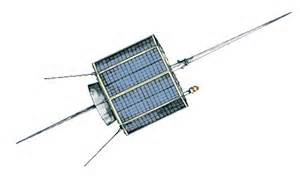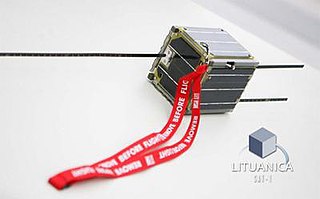AMSAT is a name for various amateur radio satellite organizations worldwide. In particular, it often refers to the Radio Amateur Satellite Corporation, headquartered in Washington, D.C. AMSAT organizations design, build, arrange launches for, and then operate (command) satellites carrying amateur radio payloads, including the OSCAR series of satellites. Other informally affiliated national organizations exist, such as AMSAT Germany (AMSAT-DL) and AMSAT Japan (JAMSAT).
UoSAT-2, which is also known as UO-11 and OSCAR-11, is a British satellite orbiting in Low Earth Orbit. The satellite functions as an amateur radio transmitter and was built at the University of Surrey. It launched into orbit in March 1984 and remains orbital and active, though unstable with irregular periods of transmission. All of the analogue telemetry channels failed in 2005, but as of 2014 the status channels were still operational. The satellite was still heard transmitting telemetry in 2023, thirty-nine years after launch.
HAMSAT also known as HAMSAT INDIA, VU2SAT and VO-52 is a microsatellite weighing 42.5 kilograms (93.7 lb), providing amateur radio satellite communications services for Indian and international amateur radio operators. This satellite carries the in-orbit designation of VO-52, and is an OSCAR series satellite.
CUTE-1.7 + APD or CO-56 (Cubesat-Oscar-56) or just OSCAR 56 was an amateur radio satellite in the form of a double CubeSat. The satellite used commercial off-the-shelf components extensively, in particular, it used the Hitachi NPD-20JWL PDA as a control computer, and it used a USB hub for sensor communications. At the end of its mission, the satellite was supposed to deploy an electrodynamic tether to help it deorbit. The satellite failed early into its mission, so the electrodynamic tether experiment probably did not happen. It was launched on February 21, 2006 on board a Japanese launcher M-V.

AMSAT-OSCAR 7, or AO-7, is the second Phase 2 amateur radio satellite constructed by the Radio Amateur Satellite Corporation (AMSAT). It was launched into Low Earth Orbit on November 15, 1974 and remained operational until a battery failure in 1981. After 21 years of apparent silence, the satellite was heard again on June 21, 2002 – 27 years after launch. At that time the public learned that the satellite had remained intermittently functional and was used surreptitiously for communication by the anticommunist opposition Fighting Solidarity during martial law in Poland.
SSETI Express was the first spacecraft to be designed and built by European students and was launched by the European Space Agency. SSETI Express is a small spacecraft, similar in size and shape to a washing machine. On board the student-built spacecraft were three CubeSat picosatellites, extremely small satellites weighing around one kg each. These were deployed one hour and forty minutes after launch. Twenty-one university groups, working from locations spread across Europe and with very different cultural backgrounds, worked together via the internet to jointly create the satellite. The expected lifetime of the mission was planned to be 2 months. SSETI Express encountered an unusually fast mission development: less than 18 months from kick-off in January 2004 to flight-readiness.
AMSAT-OSCAR 16, also known as AO-16 and PACSAT, is the in-orbit name designation of an amateur radio satellite of the OSCAR series. It was built by AMSAT and was launched on 22 January 1990 from Kourou, French Guiana on an Ariane 4 launch vehicle. It is in Sun synchronous low Earth orbit.
An amateur radio satellite is an artificial satellite built and used by amateur radio operators. It forms part of the Amateur-satellite service. These satellites use amateur radio frequency allocations to facilitate communication between amateur radio stations.
Technology Education Satellite (TechEdSat) is a successful nano-sat flight series conducted from the NASA Ames Research Center in collaboration with numerous universities. While one of the principal aims has been to introduce young professionals and university students to the practical realm of developing space flight hardware, considerable innovations have been introduced. In addition, this evolving flight platform has tested concepts for Low Earth Orbit (LEO) sample return, as well as planetary nano-sat class mission concepts.
PW-Sat is a series of Polish CubeSats designed and built by students at the Warsaw University of Technology in conjunction with the Faculty of Power and Aeronautical Engineering of Warsaw University of Technology, the Space Research Centre of Polish Academy of Sciences, and the European Space Agency. As of January 1, 2024, there have been 2 PW-Sats with a third in development. The first PW-Sat was the first Polish artificial satellite which was launched 13 February 2012 from ELA-1 at Guiana Space Centre aboard Italian-built Vega launch vehicle during its maiden voyage. After their graduation, the team that developed the original PW-Sat have also worked to develop the subsequent missions, establishing a private company named PW-Sat to design and manufacturer the PW-Sats, all of which test novel deorbiting methods, with the overall goal of the program to develop solutions to space debris.

LituanicaSAT-1 was one of the first two Lithuanian satellites. It was launched along with the second Cygnus spacecraft and 28 Flock-1 CubeSats aboard an Antares 120 carrier rocket flying from Pad 0B at the Mid-Atlantic Regional Spaceport on Wallops Island to the International Space Station. The launch was scheduled to occur in December 2013, but later was rescheduled to 9 January 2014 and occurred then. The satellite was broadcasting greetings of Lithuanian president, Mrs. Dalia Grybauskaitė. The satellite was deployed from the International Space Station via the NanoRacks CubeSat Deployer on February 28, 2014. All LituanicaSAT-1 subsystems have been turned on, tested and proved to be working properly. The mission is considered a complete success by its team of engineers. The mission ended upon the reentry and disintegration of the satellite on July 28, 2014.

FUNcube-1 is a complete educational single unit CubeSat satellite with the goal of enthusing and educating young people about radio, space, physics and electronics. It is part of a program which aims to launch more of these educational CubeSats. It is the first satellite with outreach as its primary mission.

Dove-OSCAR 17 is a Brazilian educational and amateur radio satellite (BRAMSAT) (AMSAT-BRAZIL) launched on 22 January 1990.

Es'hail 2 is a Qatari satellite, launched aboard a SpaceX Falcon 9 rocket on November 15, 2018. Es'hail 2 was built by Japan's Mitsubishi Electric company, and operates at 26° East longitude along a geostationary orbit to provide direct-to-home television services in the Middle East and North Africa region. The satellite features 24 Ku-band and 11 Ka-band transponders to provide direct broadcasting services for television, government and commercial content distribution. In addition to commercial services, the payload of Es'hail 2 includes a linear transponder with a bandwidth of 500 kHz and 8 MHz for the amateur radio satellite service, with uplink on 2.4 GHz and downlink on 10.45 GHz.
EcAMSat, or E. coli AntiMicrobial Satellite, was NASA's first 6U CubeSat, developed to investigate the effects of microgravity on the antibiotic resistance of E. coli. The spacecraft was launched aboard an Orbital ATK Antares rocket from Wallops Flight Facility on 12 November 2017, and was deployed from the International Space Station on 20 November 2017.
Fox-1D, AO-92 or AMSAT OSCAR 92 is an American amateur radio satellite. Fox-1D is a 1U CubeSat developed and built by AMSAT-NA. Fox-1D carries a single-channel transponder for mode U/V in FM. Fox-1D has an L-band converter, which allows the FM transponder to be switched on an uplink in the 23 centimetres (9.1 in) band.
Fox-1B, AO-91 or AMSAT OSCAR 91 is a United States amateur radio satellite. It is a 1U Cubesat, was built by the AMSAT-NA and carries a single-channel transponder for FM radio. The satellite has a whip antenna for the 70 cm and 23 cm bands (uplink), and a second antenna for the 2 m band (downlink). Fox-1B is the second amateur radio satellite of the Fox series of AMSAT North America.
Fox-1A, AO-85 or AMSAT OSCAR 85 is an American amateur radio satellite. It is a 1U Cubesat, was built by the AMSAT-NA and carries a single-channel transponder for FM radio. The satellite has one rod antenna each for the 70 centimetres (28 in) and 2 metres bands. To enable a satellite launch under NASA's Educational Launch of Nanosatellites (ELaNa) program, the satellite continues to carry a Penn State University student experiment.
ParkinsonSAT, PSat or Naval Academy OSCAR 84 is a U.S. technology demonstration satellite and an amateur radio satellite for Packet Radio. It was built at the U.S. Naval Academy and was planned as a double satellite. The name ParkinsonSAT was chosen in honor of Bradford Parkinson, the father of the GPS system. After successful launch, the satellite was assigned the OSCAR number 84.
Fox-1Cliff, AO-95 or AMSAT OSCAR 95 is an American amateur radio satellite. Fox-1Cliff is a 1U CubeSat built by AMSAT-NA that carries a single-channel transponder for mode U/V in FM.





